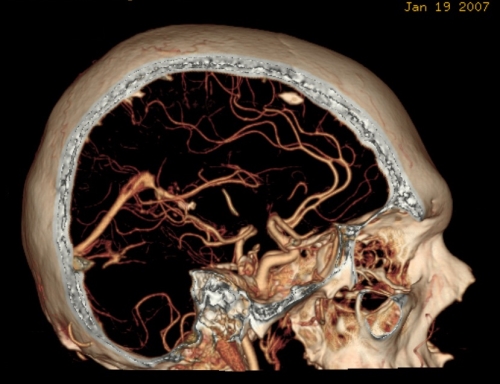Ninewells 1974-2014
Seeing & Treating
In the 1890s Dundee was home to pioneering experiments in X-Rays, and Ninewells has always provided
the latest X-Ray and imaging technology to investigate and treat its patients.


Images above: The introduction of X-Ray Computed Tomography (CT) has revolutionised medical imaging. Within five years of the first prototype in 1971, a CT head scanner was installed in Dundee. A whole-body CT scanner followed at Ninewells in 1986 (above left with radiographers Alan, Scot and Janette), funded thanks to a public appeal. The ability to examine the whole body in a non-invasive way dramatically increased the clinical use of CT. On the right, the same three radiographers are shown today in one of Tayside's five CT rooms (courtesy of Radiology department).

Image above: A CT head examination of 1981, recorded on film for viewing
on a light-box. With CT, greater detail became available and
minute differences in tissue density could be shown
(courtesy of Radiology department).

Image above: The latest CT X-Ray tubes can rotate in sub-second time to obtain multiple 0.6mm thin sections. Improved spatial resolution can show remarkable anatomical detail. Intravenous injections can outline blood vessels. Here, in a surface-rendered volume, the skull is subtracted to display the internal cerebral circulation. Imaging is now in 3D! (courtesy of Radiology department)

Image above: The first linear accelerator was installed in 1979 for radiotherapy of patients. It used high-energy x-rays to attack cancer tumours (courtesy of NHS Tayside).

Image above: This Varian 2100 CD linear accelerator dates from 2001 and is still in use for radiotherapy treatment - but due to be replaced soon! (courtesy of Radiotherapy department)